Organizational Performance Improvement Report for ALR3 Riyadh
VerifiedAdded on 2022/09/14
|18
|5658
|8
Report
AI Summary
This report delves into the intricacies of organizational performance improvement, focusing on high-performance working (HPW) and its components. It explores the link between HPW and sustainable organizational performance, emphasizing the importance of employee well-being and competitive advantage. The report also examines the barriers to HPW, such as ineffective leadership, weak codes of conduct, bureaucracy, poor communication, and lack of employee engagement. Furthermore, it analyzes the role of high-level performance management and the involvement of line managers, including the stages of the performance management cycle and the development and performance review roles. The report also highlights the significance of creating and sustaining a community of practice to build a high-performance culture, discussing techniques for building trust, enthusiasm, and commitment. The provided work is a detailed report that provides a comprehensive overview of organizational performance improvement strategies.
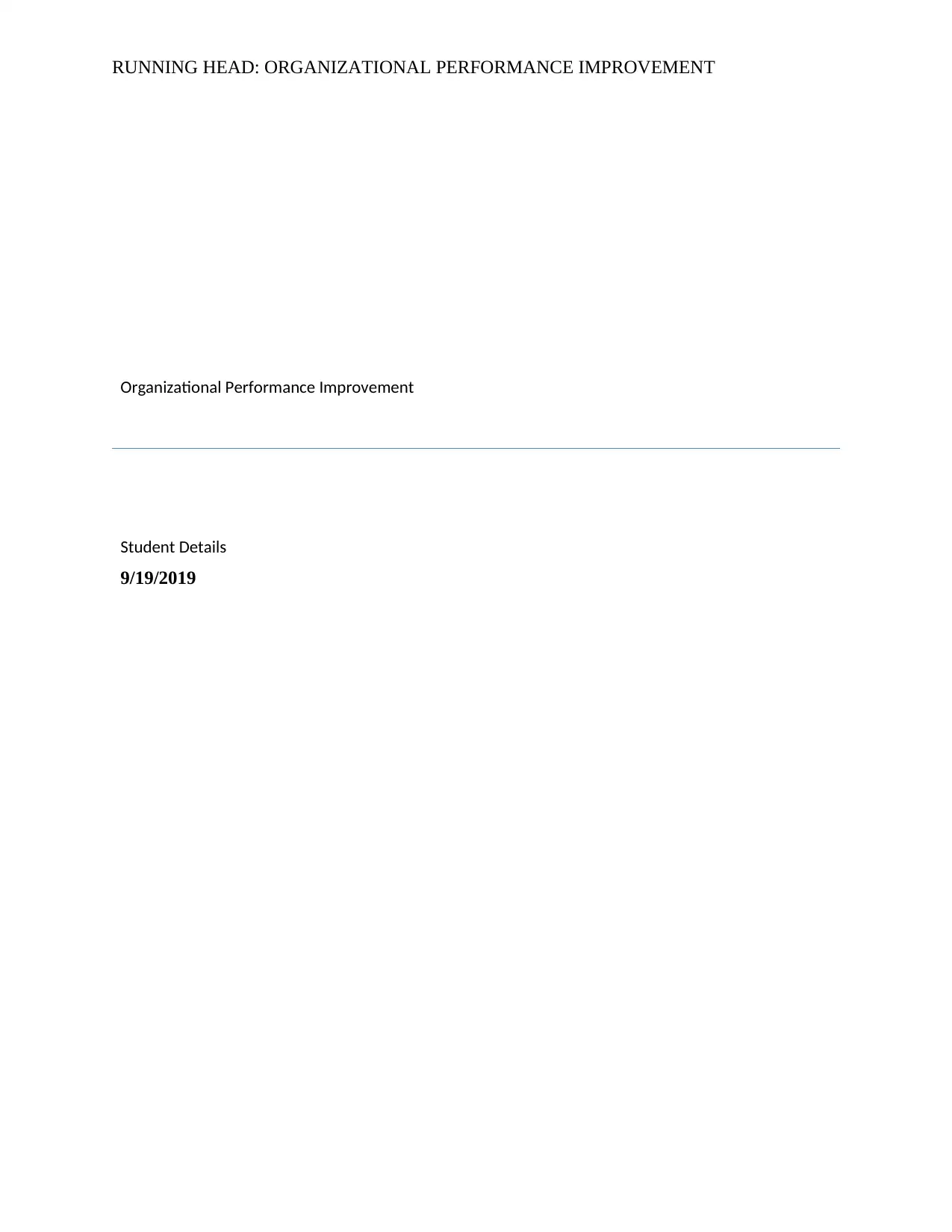
RUNNING HEAD: ORGANIZATIONAL PERFORMANCE IMPROVEMENT
Organizational Performance Improvement
Student Details
9/19/2019
Organizational Performance Improvement
Student Details
9/19/2019
Paraphrase This Document
Need a fresh take? Get an instant paraphrase of this document with our AI Paraphraser
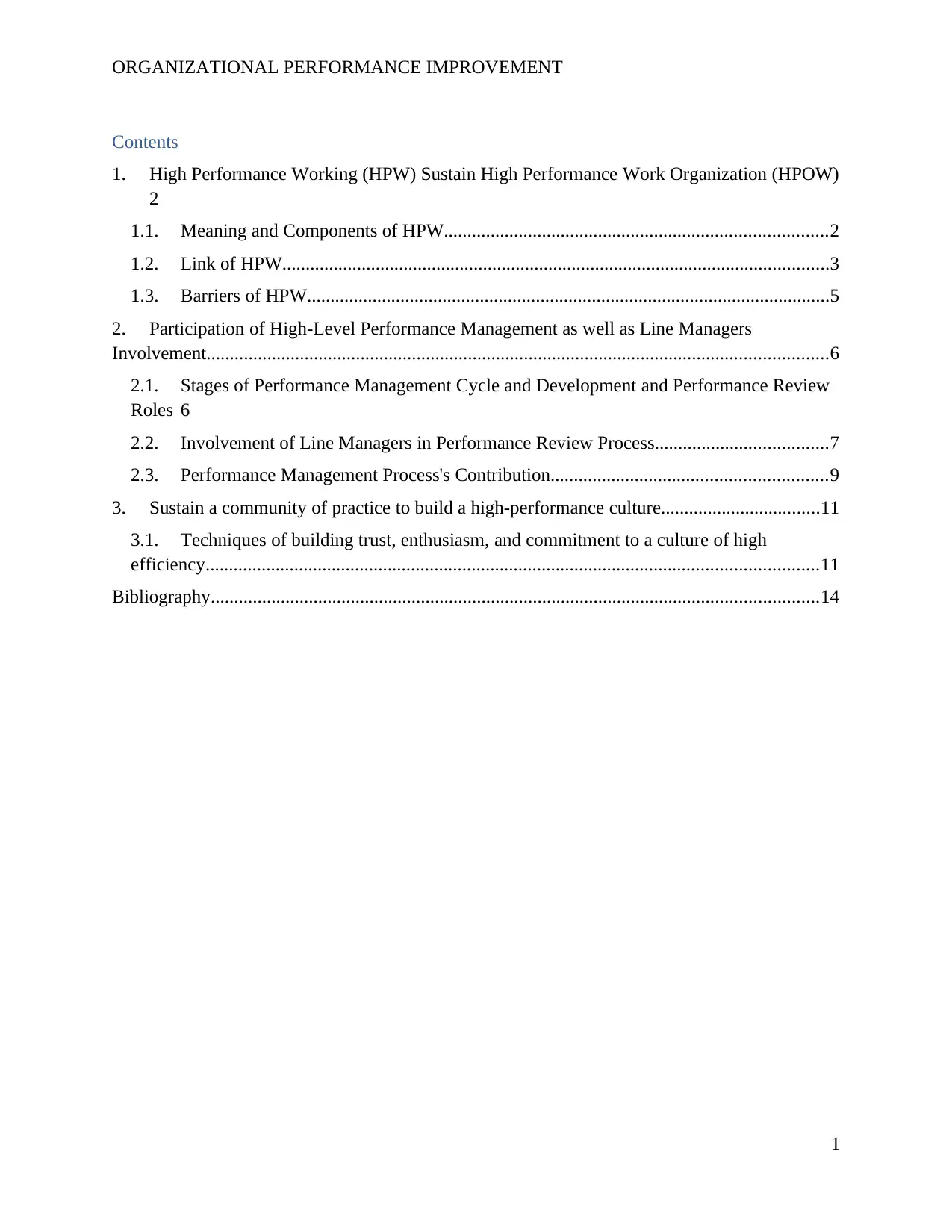
ORGANIZATIONAL PERFORMANCE IMPROVEMENT
Contents
1. High Performance Working (HPW) Sustain High Performance Work Organization (HPOW)
2
1.1. Meaning and Components of HPW..................................................................................2
1.2. Link of HPW.....................................................................................................................3
1.3. Barriers of HPW................................................................................................................5
2. Participation of High-Level Performance Management as well as Line Managers
Involvement.....................................................................................................................................6
2.1. Stages of Performance Management Cycle and Development and Performance Review
Roles 6
2.2. Involvement of Line Managers in Performance Review Process.....................................7
2.3. Performance Management Process's Contribution...........................................................9
3. Sustain a community of practice to build a high-performance culture..................................11
3.1. Techniques of building trust, enthusiasm, and commitment to a culture of high
efficiency...................................................................................................................................11
Bibliography..................................................................................................................................14
1
Contents
1. High Performance Working (HPW) Sustain High Performance Work Organization (HPOW)
2
1.1. Meaning and Components of HPW..................................................................................2
1.2. Link of HPW.....................................................................................................................3
1.3. Barriers of HPW................................................................................................................5
2. Participation of High-Level Performance Management as well as Line Managers
Involvement.....................................................................................................................................6
2.1. Stages of Performance Management Cycle and Development and Performance Review
Roles 6
2.2. Involvement of Line Managers in Performance Review Process.....................................7
2.3. Performance Management Process's Contribution...........................................................9
3. Sustain a community of practice to build a high-performance culture..................................11
3.1. Techniques of building trust, enthusiasm, and commitment to a culture of high
efficiency...................................................................................................................................11
Bibliography..................................................................................................................................14
1

ORGANIZATIONAL PERFORMANCE IMPROVEMENT
1. High Performance Working (HPW) Sustain High Performance Work Organization
(HPOW)
1.1. Meaning and Components of HPW
Higher performance Work is a standard approach to managing organizations aimed at
encouraging more efficient employee engagement and dedication to achieving high performance
levels. It is intended to improve employees ' deferred effort of their job and to make full use of
the abilities they acquire. The paradigm shift is both a challenge and an potential at all times.
Modern human resource executives face a major challenge to customize with changing company
and working environment contexts and therefore try to transform their institutions into elevated-
performance work systems with those of the correct mixture of people, process, automation and
management structure. Highly efficient Working Scheme not only sounds at innovation or
process, but it also tries to find skilled and talented individuals that can encounter the specific
needs (Alfonso J. Gil, et al., 2018).
Lately, High-Performance Working might have received attention from executives and agencies
of Human Resource. Hardly any process could work out once the appropriate people aren't there,
it will be regarded a difficult task to become an elevated-performance work organization because
all the applicable and essential elements have to fit with each other so that perhaps the system
may function seamlessly (Carl-Ulrik Schierup, et al., 2015). Elevated-performance organizations
were found to be effective as they witnessed productivity increases and very stationary long-term
revenue growth. The High-Performance Operating System is a corrective measure since many
other human resources tools as well as measures, including just-in-time production,
customization, total quality control, and flexible printing technology, can be better performed by
people who meet the specific needs (Eduardo Salas, et al., 2012).
Different organizations need to consider elevated-performance work as a priority. This is so
because while the findings of high-performance employment are several organizational outcomes
along with higher productivity, higher profit margins, reduced expenses, better client
responsiveness as well as greater freedom. High performance job is a functional system that
offers productivity increases if employees are motivated, engaged and given autonomy (Emily A.
2
1. High Performance Working (HPW) Sustain High Performance Work Organization
(HPOW)
1.1. Meaning and Components of HPW
Higher performance Work is a standard approach to managing organizations aimed at
encouraging more efficient employee engagement and dedication to achieving high performance
levels. It is intended to improve employees ' deferred effort of their job and to make full use of
the abilities they acquire. The paradigm shift is both a challenge and an potential at all times.
Modern human resource executives face a major challenge to customize with changing company
and working environment contexts and therefore try to transform their institutions into elevated-
performance work systems with those of the correct mixture of people, process, automation and
management structure. Highly efficient Working Scheme not only sounds at innovation or
process, but it also tries to find skilled and talented individuals that can encounter the specific
needs (Alfonso J. Gil, et al., 2018).
Lately, High-Performance Working might have received attention from executives and agencies
of Human Resource. Hardly any process could work out once the appropriate people aren't there,
it will be regarded a difficult task to become an elevated-performance work organization because
all the applicable and essential elements have to fit with each other so that perhaps the system
may function seamlessly (Carl-Ulrik Schierup, et al., 2015). Elevated-performance organizations
were found to be effective as they witnessed productivity increases and very stationary long-term
revenue growth. The High-Performance Operating System is a corrective measure since many
other human resources tools as well as measures, including just-in-time production,
customization, total quality control, and flexible printing technology, can be better performed by
people who meet the specific needs (Eduardo Salas, et al., 2012).
Different organizations need to consider elevated-performance work as a priority. This is so
because while the findings of high-performance employment are several organizational outcomes
along with higher productivity, higher profit margins, reduced expenses, better client
responsiveness as well as greater freedom. High performance job is a functional system that
offers productivity increases if employees are motivated, engaged and given autonomy (Emily A.
2
⊘ This is a preview!⊘
Do you want full access?
Subscribe today to unlock all pages.

Trusted by 1+ million students worldwide
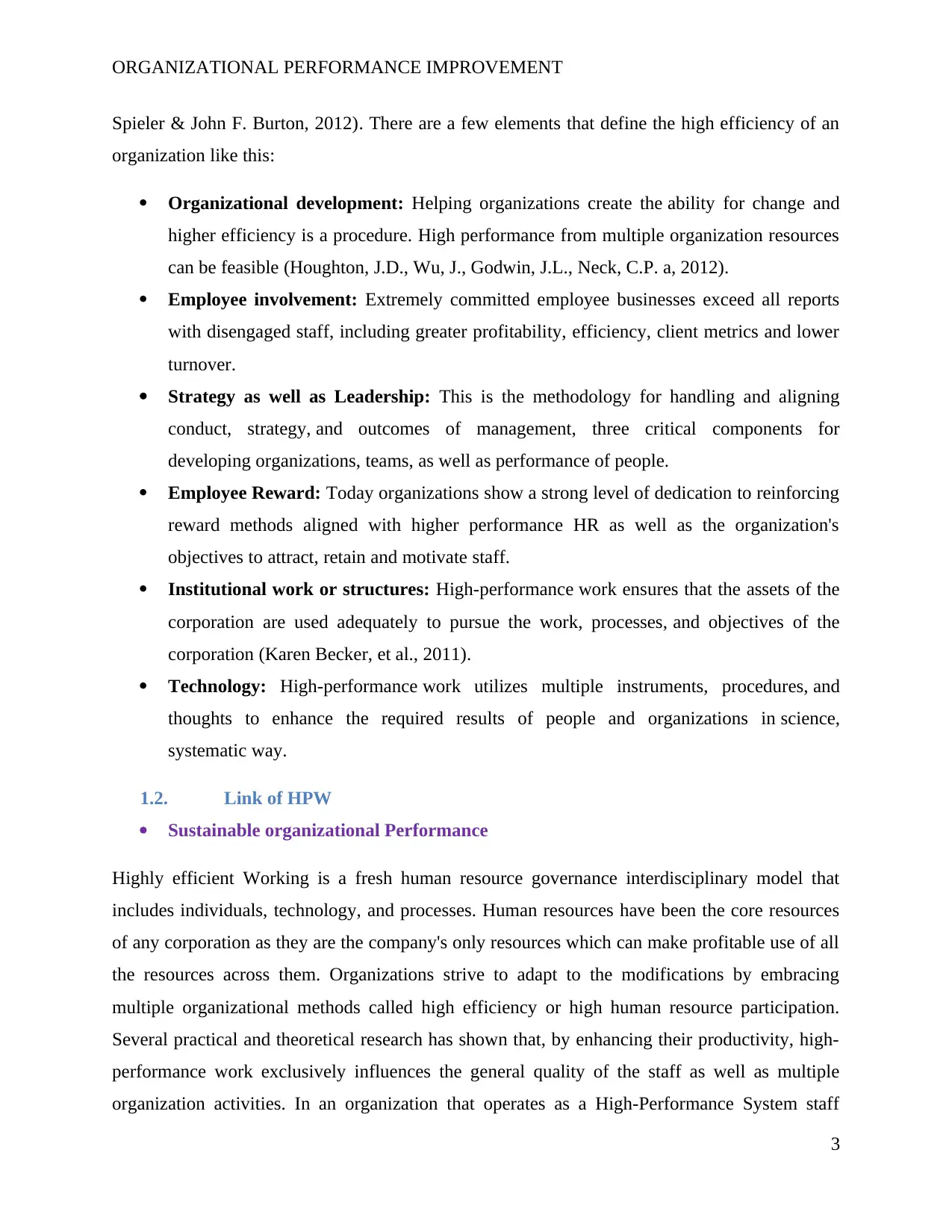
ORGANIZATIONAL PERFORMANCE IMPROVEMENT
Spieler & John F. Burton, 2012). There are a few elements that define the high efficiency of an
organization like this:
Organizational development: Helping organizations create the ability for change and
higher efficiency is a procedure. High performance from multiple organization resources
can be feasible (Houghton, J.D., Wu, J., Godwin, J.L., Neck, C.P. a, 2012).
Employee involvement: Extremely committed employee businesses exceed all reports
with disengaged staff, including greater profitability, efficiency, client metrics and lower
turnover.
Strategy as well as Leadership: This is the methodology for handling and aligning
conduct, strategy, and outcomes of management, three critical components for
developing organizations, teams, as well as performance of people.
Employee Reward: Today organizations show a strong level of dedication to reinforcing
reward methods aligned with higher performance HR as well as the organization's
objectives to attract, retain and motivate staff.
Institutional work or structures: High-performance work ensures that the assets of the
corporation are used adequately to pursue the work, processes, and objectives of the
corporation (Karen Becker, et al., 2011).
Technology: High-performance work utilizes multiple instruments, procedures, and
thoughts to enhance the required results of people and organizations in science,
systematic way.
1.2. Link of HPW
Sustainable organizational Performance
Highly efficient Working is a fresh human resource governance interdisciplinary model that
includes individuals, technology, and processes. Human resources have been the core resources
of any corporation as they are the company's only resources which can make profitable use of all
the resources across them. Organizations strive to adapt to the modifications by embracing
multiple organizational methods called high efficiency or high human resource participation.
Several practical and theoretical research has shown that, by enhancing their productivity, high-
performance work exclusively influences the general quality of the staff as well as multiple
organization activities. In an organization that operates as a High-Performance System staff
3
Spieler & John F. Burton, 2012). There are a few elements that define the high efficiency of an
organization like this:
Organizational development: Helping organizations create the ability for change and
higher efficiency is a procedure. High performance from multiple organization resources
can be feasible (Houghton, J.D., Wu, J., Godwin, J.L., Neck, C.P. a, 2012).
Employee involvement: Extremely committed employee businesses exceed all reports
with disengaged staff, including greater profitability, efficiency, client metrics and lower
turnover.
Strategy as well as Leadership: This is the methodology for handling and aligning
conduct, strategy, and outcomes of management, three critical components for
developing organizations, teams, as well as performance of people.
Employee Reward: Today organizations show a strong level of dedication to reinforcing
reward methods aligned with higher performance HR as well as the organization's
objectives to attract, retain and motivate staff.
Institutional work or structures: High-performance work ensures that the assets of the
corporation are used adequately to pursue the work, processes, and objectives of the
corporation (Karen Becker, et al., 2011).
Technology: High-performance work utilizes multiple instruments, procedures, and
thoughts to enhance the required results of people and organizations in science,
systematic way.
1.2. Link of HPW
Sustainable organizational Performance
Highly efficient Working is a fresh human resource governance interdisciplinary model that
includes individuals, technology, and processes. Human resources have been the core resources
of any corporation as they are the company's only resources which can make profitable use of all
the resources across them. Organizations strive to adapt to the modifications by embracing
multiple organizational methods called high efficiency or high human resource participation.
Several practical and theoretical research has shown that, by enhancing their productivity, high-
performance work exclusively influences the general quality of the staff as well as multiple
organization activities. In an organization that operates as a High-Performance System staff
3
Paraphrase This Document
Need a fresh take? Get an instant paraphrase of this document with our AI Paraphraser
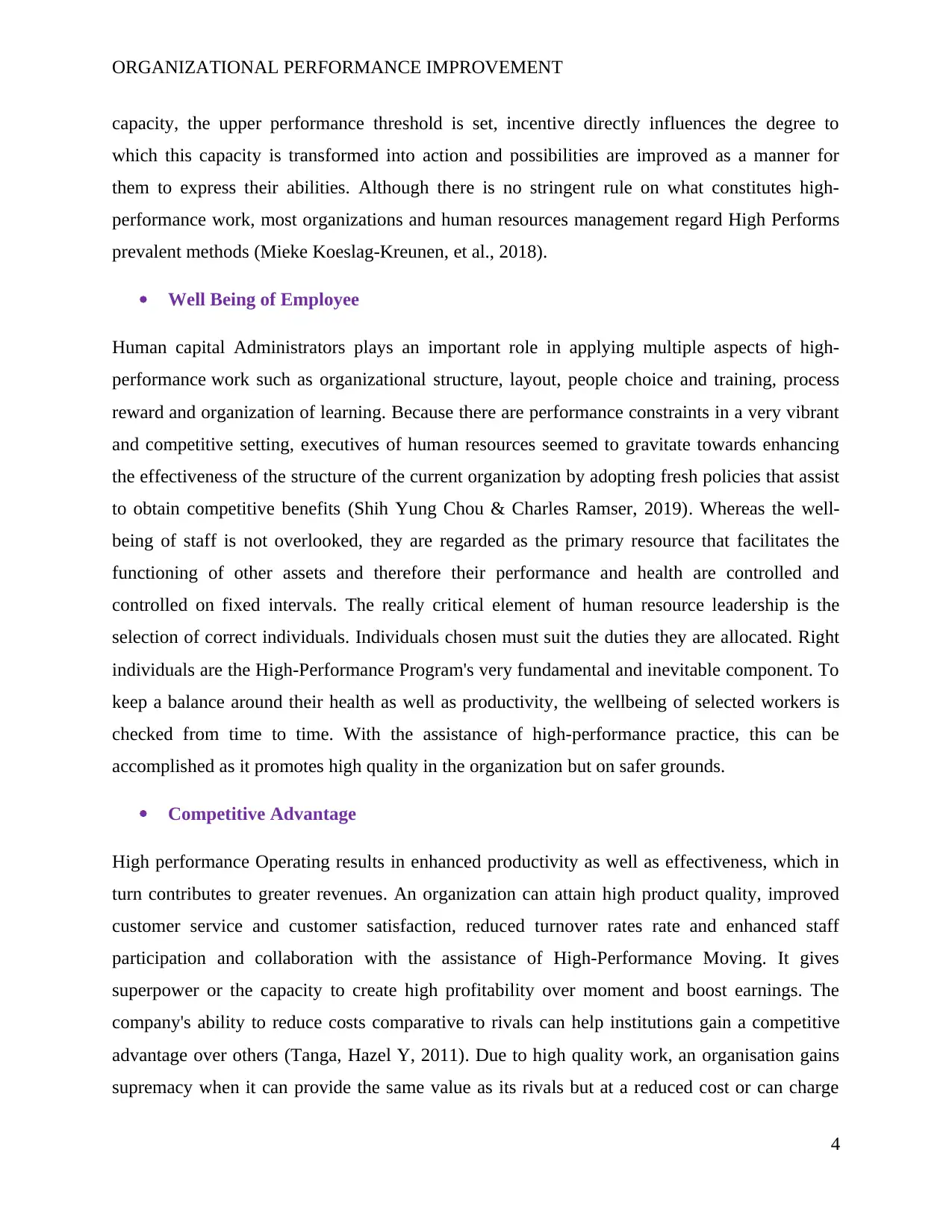
ORGANIZATIONAL PERFORMANCE IMPROVEMENT
capacity, the upper performance threshold is set, incentive directly influences the degree to
which this capacity is transformed into action and possibilities are improved as a manner for
them to express their abilities. Although there is no stringent rule on what constitutes high-
performance work, most organizations and human resources management regard High Performs
prevalent methods (Mieke Koeslag-Kreunen, et al., 2018).
Well Being of Employee
Human capital Administrators plays an important role in applying multiple aspects of high-
performance work such as organizational structure, layout, people choice and training, process
reward and organization of learning. Because there are performance constraints in a very vibrant
and competitive setting, executives of human resources seemed to gravitate towards enhancing
the effectiveness of the structure of the current organization by adopting fresh policies that assist
to obtain competitive benefits (Shih Yung Chou & Charles Ramser, 2019). Whereas the well-
being of staff is not overlooked, they are regarded as the primary resource that facilitates the
functioning of other assets and therefore their performance and health are controlled and
controlled on fixed intervals. The really critical element of human resource leadership is the
selection of correct individuals. Individuals chosen must suit the duties they are allocated. Right
individuals are the High-Performance Program's very fundamental and inevitable component. To
keep a balance around their health as well as productivity, the wellbeing of selected workers is
checked from time to time. With the assistance of high-performance practice, this can be
accomplished as it promotes high quality in the organization but on safer grounds.
Competitive Advantage
High performance Operating results in enhanced productivity as well as effectiveness, which in
turn contributes to greater revenues. An organization can attain high product quality, improved
customer service and customer satisfaction, reduced turnover rates rate and enhanced staff
participation and collaboration with the assistance of High-Performance Moving. It gives
superpower or the capacity to create high profitability over moment and boost earnings. The
company's ability to reduce costs comparative to rivals can help institutions gain a competitive
advantage over others (Tanga, Hazel Y, 2011). Due to high quality work, an organisation gains
supremacy when it can provide the same value as its rivals but at a reduced cost or can charge
4
capacity, the upper performance threshold is set, incentive directly influences the degree to
which this capacity is transformed into action and possibilities are improved as a manner for
them to express their abilities. Although there is no stringent rule on what constitutes high-
performance work, most organizations and human resources management regard High Performs
prevalent methods (Mieke Koeslag-Kreunen, et al., 2018).
Well Being of Employee
Human capital Administrators plays an important role in applying multiple aspects of high-
performance work such as organizational structure, layout, people choice and training, process
reward and organization of learning. Because there are performance constraints in a very vibrant
and competitive setting, executives of human resources seemed to gravitate towards enhancing
the effectiveness of the structure of the current organization by adopting fresh policies that assist
to obtain competitive benefits (Shih Yung Chou & Charles Ramser, 2019). Whereas the well-
being of staff is not overlooked, they are regarded as the primary resource that facilitates the
functioning of other assets and therefore their performance and health are controlled and
controlled on fixed intervals. The really critical element of human resource leadership is the
selection of correct individuals. Individuals chosen must suit the duties they are allocated. Right
individuals are the High-Performance Program's very fundamental and inevitable component. To
keep a balance around their health as well as productivity, the wellbeing of selected workers is
checked from time to time. With the assistance of high-performance practice, this can be
accomplished as it promotes high quality in the organization but on safer grounds.
Competitive Advantage
High performance Operating results in enhanced productivity as well as effectiveness, which in
turn contributes to greater revenues. An organization can attain high product quality, improved
customer service and customer satisfaction, reduced turnover rates rate and enhanced staff
participation and collaboration with the assistance of High-Performance Moving. It gives
superpower or the capacity to create high profitability over moment and boost earnings. The
company's ability to reduce costs comparative to rivals can help institutions gain a competitive
advantage over others (Tanga, Hazel Y, 2011). Due to high quality work, an organisation gains
supremacy when it can provide the same value as its rivals but at a reduced cost or can charge
4
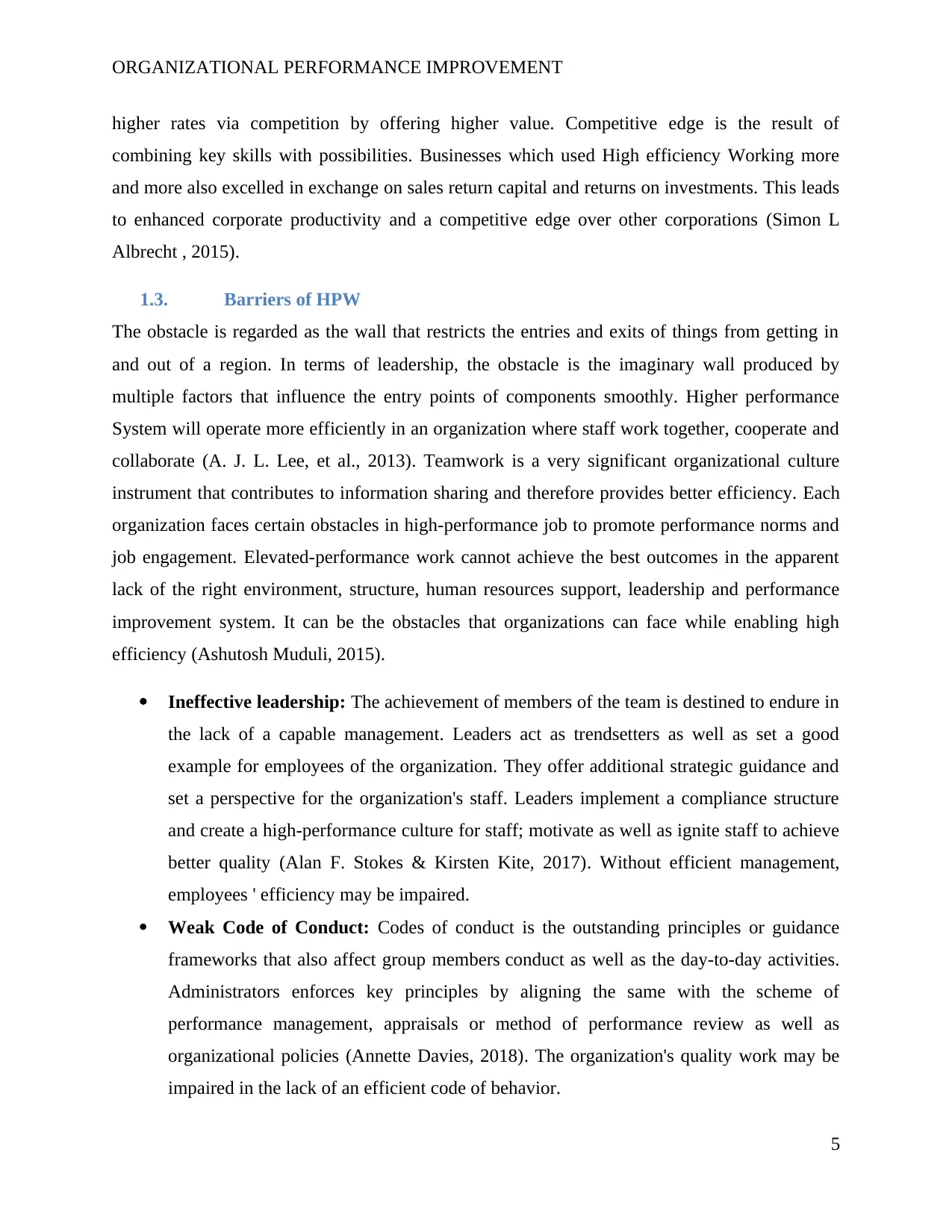
ORGANIZATIONAL PERFORMANCE IMPROVEMENT
higher rates via competition by offering higher value. Competitive edge is the result of
combining key skills with possibilities. Businesses which used High efficiency Working more
and more also excelled in exchange on sales return capital and returns on investments. This leads
to enhanced corporate productivity and a competitive edge over other corporations (Simon L
Albrecht , 2015).
1.3. Barriers of HPW
The obstacle is regarded as the wall that restricts the entries and exits of things from getting in
and out of a region. In terms of leadership, the obstacle is the imaginary wall produced by
multiple factors that influence the entry points of components smoothly. Higher performance
System will operate more efficiently in an organization where staff work together, cooperate and
collaborate (A. J. L. Lee, et al., 2013). Teamwork is a very significant organizational culture
instrument that contributes to information sharing and therefore provides better efficiency. Each
organization faces certain obstacles in high-performance job to promote performance norms and
job engagement. Elevated-performance work cannot achieve the best outcomes in the apparent
lack of the right environment, structure, human resources support, leadership and performance
improvement system. It can be the obstacles that organizations can face while enabling high
efficiency (Ashutosh Muduli, 2015).
Ineffective leadership: The achievement of members of the team is destined to endure in
the lack of a capable management. Leaders act as trendsetters as well as set a good
example for employees of the organization. They offer additional strategic guidance and
set a perspective for the organization's staff. Leaders implement a compliance structure
and create a high-performance culture for staff; motivate as well as ignite staff to achieve
better quality (Alan F. Stokes & Kirsten Kite, 2017). Without efficient management,
employees ' efficiency may be impaired.
Weak Code of Conduct: Codes of conduct is the outstanding principles or guidance
frameworks that also affect group members conduct as well as the day-to-day activities.
Administrators enforces key principles by aligning the same with the scheme of
performance management, appraisals or method of performance review as well as
organizational policies (Annette Davies, 2018). The organization's quality work may be
impaired in the lack of an efficient code of behavior.
5
higher rates via competition by offering higher value. Competitive edge is the result of
combining key skills with possibilities. Businesses which used High efficiency Working more
and more also excelled in exchange on sales return capital and returns on investments. This leads
to enhanced corporate productivity and a competitive edge over other corporations (Simon L
Albrecht , 2015).
1.3. Barriers of HPW
The obstacle is regarded as the wall that restricts the entries and exits of things from getting in
and out of a region. In terms of leadership, the obstacle is the imaginary wall produced by
multiple factors that influence the entry points of components smoothly. Higher performance
System will operate more efficiently in an organization where staff work together, cooperate and
collaborate (A. J. L. Lee, et al., 2013). Teamwork is a very significant organizational culture
instrument that contributes to information sharing and therefore provides better efficiency. Each
organization faces certain obstacles in high-performance job to promote performance norms and
job engagement. Elevated-performance work cannot achieve the best outcomes in the apparent
lack of the right environment, structure, human resources support, leadership and performance
improvement system. It can be the obstacles that organizations can face while enabling high
efficiency (Ashutosh Muduli, 2015).
Ineffective leadership: The achievement of members of the team is destined to endure in
the lack of a capable management. Leaders act as trendsetters as well as set a good
example for employees of the organization. They offer additional strategic guidance and
set a perspective for the organization's staff. Leaders implement a compliance structure
and create a high-performance culture for staff; motivate as well as ignite staff to achieve
better quality (Alan F. Stokes & Kirsten Kite, 2017). Without efficient management,
employees ' efficiency may be impaired.
Weak Code of Conduct: Codes of conduct is the outstanding principles or guidance
frameworks that also affect group members conduct as well as the day-to-day activities.
Administrators enforces key principles by aligning the same with the scheme of
performance management, appraisals or method of performance review as well as
organizational policies (Annette Davies, 2018). The organization's quality work may be
impaired in the lack of an efficient code of behavior.
5
⊘ This is a preview!⊘
Do you want full access?
Subscribe today to unlock all pages.

Trusted by 1+ million students worldwide
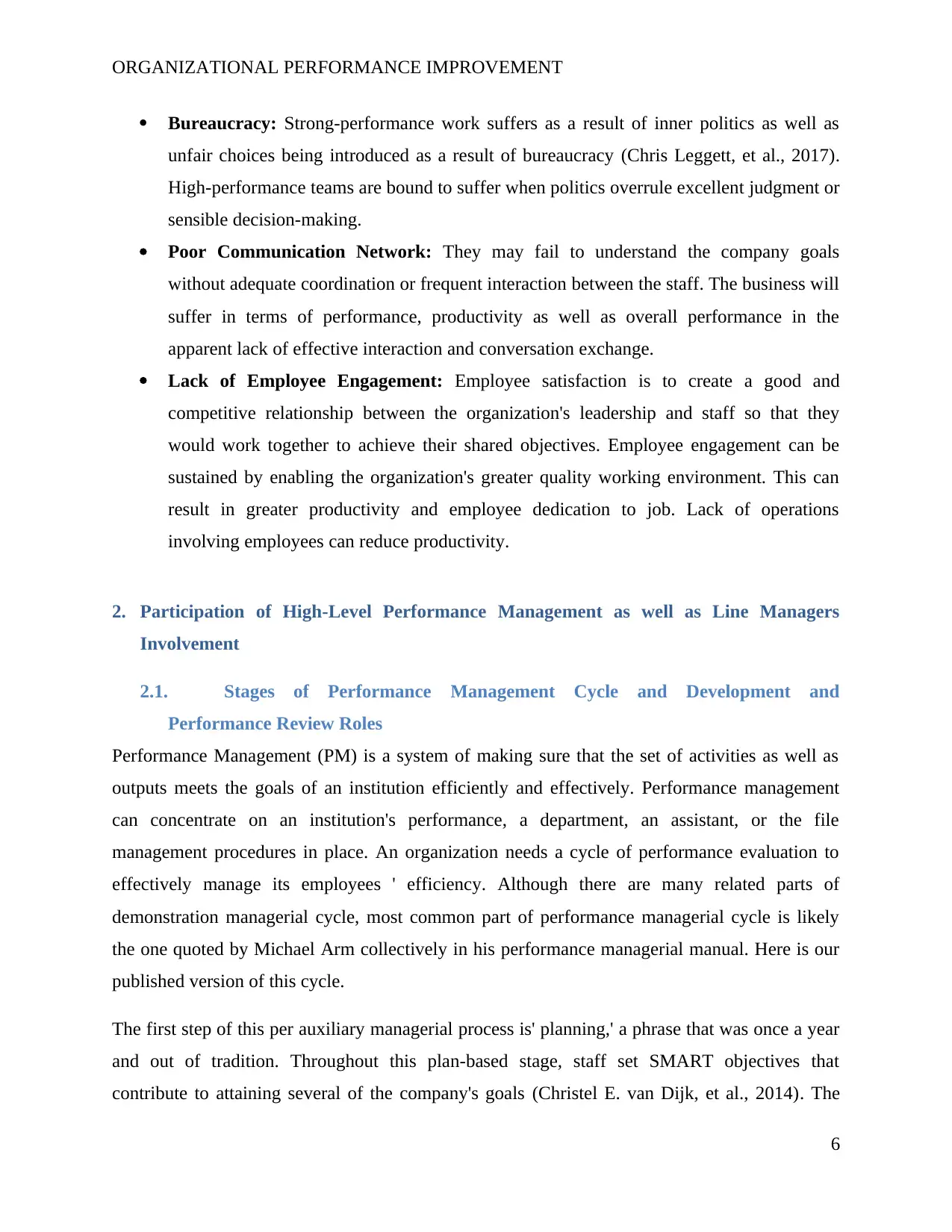
ORGANIZATIONAL PERFORMANCE IMPROVEMENT
Bureaucracy: Strong-performance work suffers as a result of inner politics as well as
unfair choices being introduced as a result of bureaucracy (Chris Leggett, et al., 2017).
High-performance teams are bound to suffer when politics overrule excellent judgment or
sensible decision-making.
Poor Communication Network: They may fail to understand the company goals
without adequate coordination or frequent interaction between the staff. The business will
suffer in terms of performance, productivity as well as overall performance in the
apparent lack of effective interaction and conversation exchange.
Lack of Employee Engagement: Employee satisfaction is to create a good and
competitive relationship between the organization's leadership and staff so that they
would work together to achieve their shared objectives. Employee engagement can be
sustained by enabling the organization's greater quality working environment. This can
result in greater productivity and employee dedication to job. Lack of operations
involving employees can reduce productivity.
2. Participation of High-Level Performance Management as well as Line Managers
Involvement
2.1. Stages of Performance Management Cycle and Development and
Performance Review Roles
Performance Management (PM) is a system of making sure that the set of activities as well as
outputs meets the goals of an institution efficiently and effectively. Performance management
can concentrate on an institution's performance, a department, an assistant, or the file
management procedures in place. An organization needs a cycle of performance evaluation to
effectively manage its employees ' efficiency. Although there are many related parts of
demonstration managerial cycle, most common part of performance managerial cycle is likely
the one quoted by Michael Arm collectively in his performance managerial manual. Here is our
published version of this cycle.
The first step of this per auxiliary managerial process is' planning,' a phrase that was once a year
and out of tradition. Throughout this plan-based stage, staff set SMART objectives that
contribute to attaining several of the company's goals (Christel E. van Dijk, et al., 2014). The
6
Bureaucracy: Strong-performance work suffers as a result of inner politics as well as
unfair choices being introduced as a result of bureaucracy (Chris Leggett, et al., 2017).
High-performance teams are bound to suffer when politics overrule excellent judgment or
sensible decision-making.
Poor Communication Network: They may fail to understand the company goals
without adequate coordination or frequent interaction between the staff. The business will
suffer in terms of performance, productivity as well as overall performance in the
apparent lack of effective interaction and conversation exchange.
Lack of Employee Engagement: Employee satisfaction is to create a good and
competitive relationship between the organization's leadership and staff so that they
would work together to achieve their shared objectives. Employee engagement can be
sustained by enabling the organization's greater quality working environment. This can
result in greater productivity and employee dedication to job. Lack of operations
involving employees can reduce productivity.
2. Participation of High-Level Performance Management as well as Line Managers
Involvement
2.1. Stages of Performance Management Cycle and Development and
Performance Review Roles
Performance Management (PM) is a system of making sure that the set of activities as well as
outputs meets the goals of an institution efficiently and effectively. Performance management
can concentrate on an institution's performance, a department, an assistant, or the file
management procedures in place. An organization needs a cycle of performance evaluation to
effectively manage its employees ' efficiency. Although there are many related parts of
demonstration managerial cycle, most common part of performance managerial cycle is likely
the one quoted by Michael Arm collectively in his performance managerial manual. Here is our
published version of this cycle.
The first step of this per auxiliary managerial process is' planning,' a phrase that was once a year
and out of tradition. Throughout this plan-based stage, staff set SMART objectives that
contribute to attaining several of the company's goals (Christel E. van Dijk, et al., 2014). The
6
Paraphrase This Document
Need a fresh take? Get an instant paraphrase of this document with our AI Paraphraser
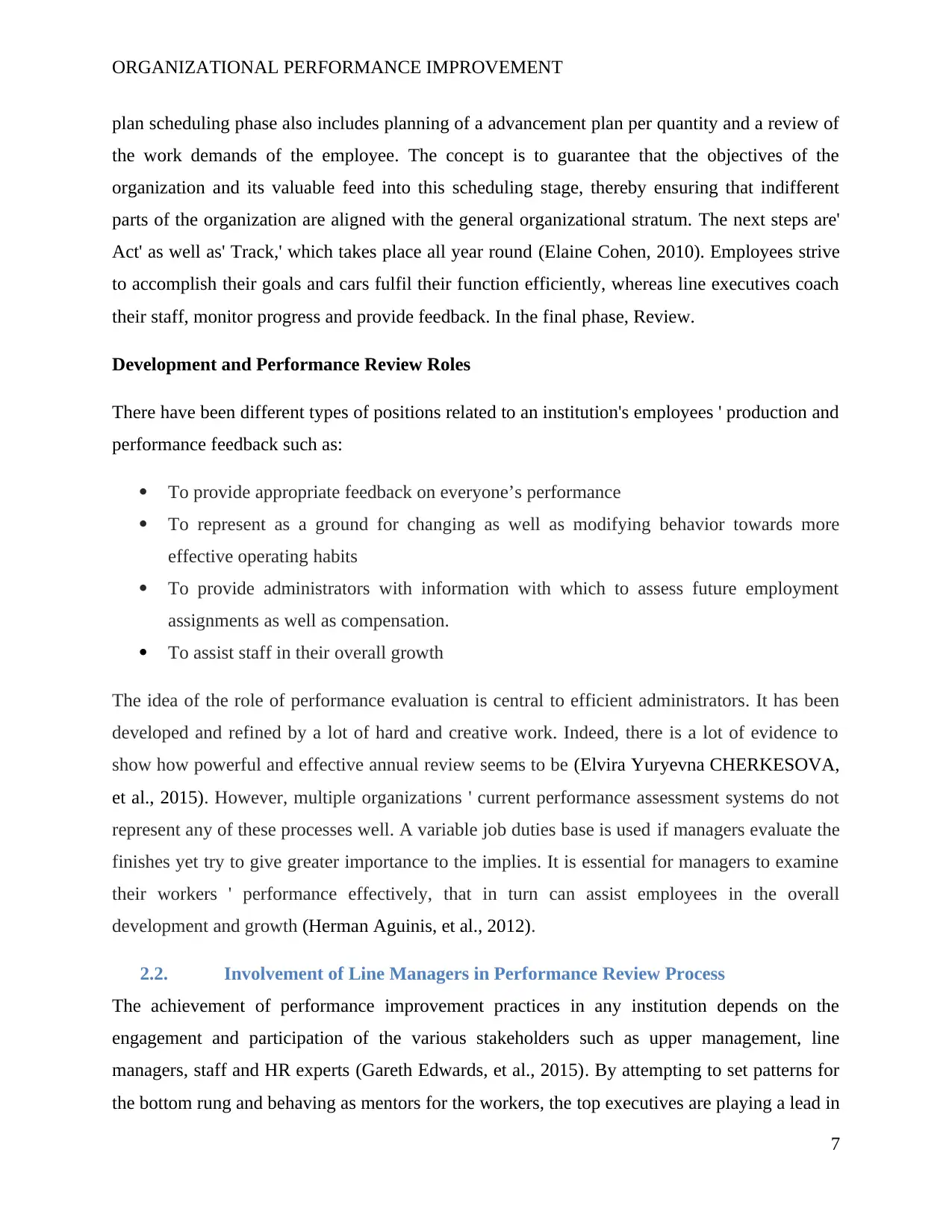
ORGANIZATIONAL PERFORMANCE IMPROVEMENT
plan scheduling phase also includes planning of a advancement plan per quantity and a review of
the work demands of the employee. The concept is to guarantee that the objectives of the
organization and its valuable feed into this scheduling stage, thereby ensuring that indifferent
parts of the organization are aligned with the general organizational stratum. The next steps are'
Act' as well as' Track,' which takes place all year round (Elaine Cohen, 2010). Employees strive
to accomplish their goals and cars fulfil their function efficiently, whereas line executives coach
their staff, monitor progress and provide feedback. In the final phase, Review.
Development and Performance Review Roles
There have been different types of positions related to an institution's employees ' production and
performance feedback such as:
To provide appropriate feedback on everyone’s performance
To represent as a ground for changing as well as modifying behavior towards more
effective operating habits
To provide administrators with information with which to assess future employment
assignments as well as compensation.
To assist staff in their overall growth
The idea of the role of performance evaluation is central to efficient administrators. It has been
developed and refined by a lot of hard and creative work. Indeed, there is a lot of evidence to
show how powerful and effective annual review seems to be (Elvira Yuryevna CHERKESOVA,
et al., 2015). However, multiple organizations ' current performance assessment systems do not
represent any of these processes well. A variable job duties base is used if managers evaluate the
finishes yet try to give greater importance to the implies. It is essential for managers to examine
their workers ' performance effectively, that in turn can assist employees in the overall
development and growth (Herman Aguinis, et al., 2012).
2.2. Involvement of Line Managers in Performance Review Process
The achievement of performance improvement practices in any institution depends on the
engagement and participation of the various stakeholders such as upper management, line
managers, staff and HR experts (Gareth Edwards, et al., 2015). By attempting to set patterns for
the bottom rung and behaving as mentors for the workers, the top executives are playing a lead in
7
plan scheduling phase also includes planning of a advancement plan per quantity and a review of
the work demands of the employee. The concept is to guarantee that the objectives of the
organization and its valuable feed into this scheduling stage, thereby ensuring that indifferent
parts of the organization are aligned with the general organizational stratum. The next steps are'
Act' as well as' Track,' which takes place all year round (Elaine Cohen, 2010). Employees strive
to accomplish their goals and cars fulfil their function efficiently, whereas line executives coach
their staff, monitor progress and provide feedback. In the final phase, Review.
Development and Performance Review Roles
There have been different types of positions related to an institution's employees ' production and
performance feedback such as:
To provide appropriate feedback on everyone’s performance
To represent as a ground for changing as well as modifying behavior towards more
effective operating habits
To provide administrators with information with which to assess future employment
assignments as well as compensation.
To assist staff in their overall growth
The idea of the role of performance evaluation is central to efficient administrators. It has been
developed and refined by a lot of hard and creative work. Indeed, there is a lot of evidence to
show how powerful and effective annual review seems to be (Elvira Yuryevna CHERKESOVA,
et al., 2015). However, multiple organizations ' current performance assessment systems do not
represent any of these processes well. A variable job duties base is used if managers evaluate the
finishes yet try to give greater importance to the implies. It is essential for managers to examine
their workers ' performance effectively, that in turn can assist employees in the overall
development and growth (Herman Aguinis, et al., 2012).
2.2. Involvement of Line Managers in Performance Review Process
The achievement of performance improvement practices in any institution depends on the
engagement and participation of the various stakeholders such as upper management, line
managers, staff and HR experts (Gareth Edwards, et al., 2015). By attempting to set patterns for
the bottom rung and behaving as mentors for the workers, the top executives are playing a lead in
7
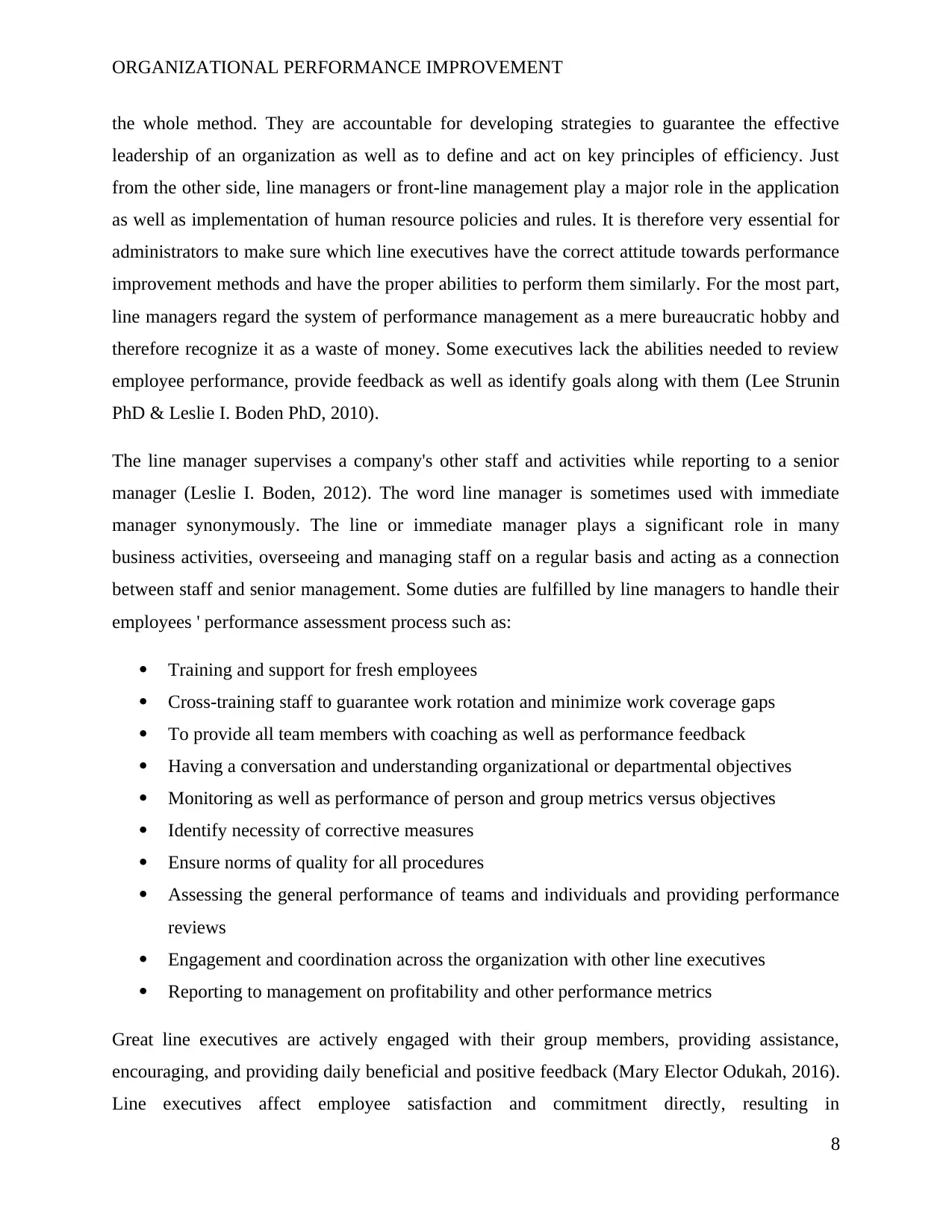
ORGANIZATIONAL PERFORMANCE IMPROVEMENT
the whole method. They are accountable for developing strategies to guarantee the effective
leadership of an organization as well as to define and act on key principles of efficiency. Just
from the other side, line managers or front-line management play a major role in the application
as well as implementation of human resource policies and rules. It is therefore very essential for
administrators to make sure which line executives have the correct attitude towards performance
improvement methods and have the proper abilities to perform them similarly. For the most part,
line managers regard the system of performance management as a mere bureaucratic hobby and
therefore recognize it as a waste of money. Some executives lack the abilities needed to review
employee performance, provide feedback as well as identify goals along with them (Lee Strunin
PhD & Leslie I. Boden PhD, 2010).
The line manager supervises a company's other staff and activities while reporting to a senior
manager (Leslie I. Boden, 2012). The word line manager is sometimes used with immediate
manager synonymously. The line or immediate manager plays a significant role in many
business activities, overseeing and managing staff on a regular basis and acting as a connection
between staff and senior management. Some duties are fulfilled by line managers to handle their
employees ' performance assessment process such as:
Training and support for fresh employees
Cross-training staff to guarantee work rotation and minimize work coverage gaps
To provide all team members with coaching as well as performance feedback
Having a conversation and understanding organizational or departmental objectives
Monitoring as well as performance of person and group metrics versus objectives
Identify necessity of corrective measures
Ensure norms of quality for all procedures
Assessing the general performance of teams and individuals and providing performance
reviews
Engagement and coordination across the organization with other line executives
Reporting to management on profitability and other performance metrics
Great line executives are actively engaged with their group members, providing assistance,
encouraging, and providing daily beneficial and positive feedback (Mary Elector Odukah, 2016).
Line executives affect employee satisfaction and commitment directly, resulting in
8
the whole method. They are accountable for developing strategies to guarantee the effective
leadership of an organization as well as to define and act on key principles of efficiency. Just
from the other side, line managers or front-line management play a major role in the application
as well as implementation of human resource policies and rules. It is therefore very essential for
administrators to make sure which line executives have the correct attitude towards performance
improvement methods and have the proper abilities to perform them similarly. For the most part,
line managers regard the system of performance management as a mere bureaucratic hobby and
therefore recognize it as a waste of money. Some executives lack the abilities needed to review
employee performance, provide feedback as well as identify goals along with them (Lee Strunin
PhD & Leslie I. Boden PhD, 2010).
The line manager supervises a company's other staff and activities while reporting to a senior
manager (Leslie I. Boden, 2012). The word line manager is sometimes used with immediate
manager synonymously. The line or immediate manager plays a significant role in many
business activities, overseeing and managing staff on a regular basis and acting as a connection
between staff and senior management. Some duties are fulfilled by line managers to handle their
employees ' performance assessment process such as:
Training and support for fresh employees
Cross-training staff to guarantee work rotation and minimize work coverage gaps
To provide all team members with coaching as well as performance feedback
Having a conversation and understanding organizational or departmental objectives
Monitoring as well as performance of person and group metrics versus objectives
Identify necessity of corrective measures
Ensure norms of quality for all procedures
Assessing the general performance of teams and individuals and providing performance
reviews
Engagement and coordination across the organization with other line executives
Reporting to management on profitability and other performance metrics
Great line executives are actively engaged with their group members, providing assistance,
encouraging, and providing daily beneficial and positive feedback (Mary Elector Odukah, 2016).
Line executives affect employee satisfaction and commitment directly, resulting in
8
⊘ This is a preview!⊘
Do you want full access?
Subscribe today to unlock all pages.

Trusted by 1+ million students worldwide
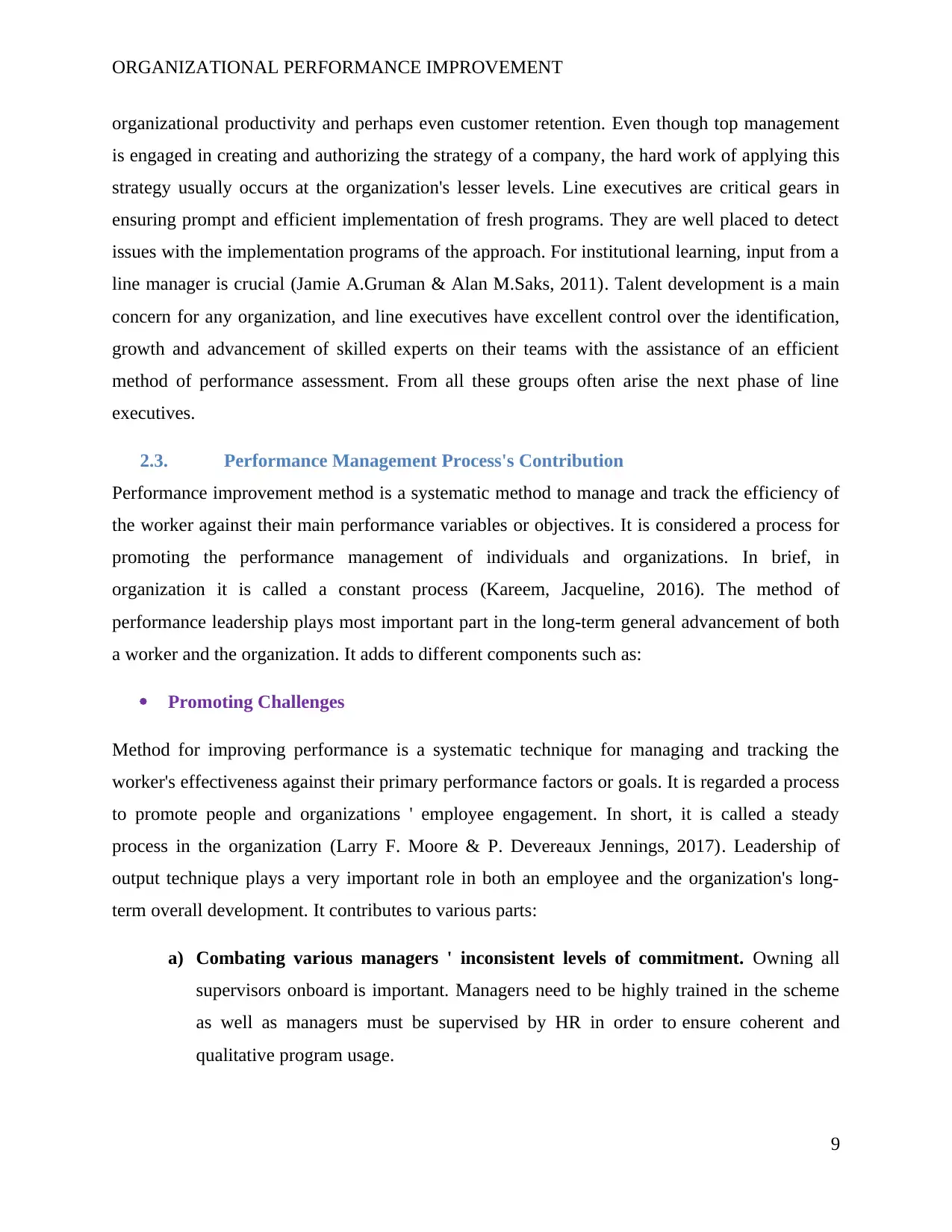
ORGANIZATIONAL PERFORMANCE IMPROVEMENT
organizational productivity and perhaps even customer retention. Even though top management
is engaged in creating and authorizing the strategy of a company, the hard work of applying this
strategy usually occurs at the organization's lesser levels. Line executives are critical gears in
ensuring prompt and efficient implementation of fresh programs. They are well placed to detect
issues with the implementation programs of the approach. For institutional learning, input from a
line manager is crucial (Jamie A.Gruman & Alan M.Saks, 2011). Talent development is a main
concern for any organization, and line executives have excellent control over the identification,
growth and advancement of skilled experts on their teams with the assistance of an efficient
method of performance assessment. From all these groups often arise the next phase of line
executives.
2.3. Performance Management Process's Contribution
Performance improvement method is a systematic method to manage and track the efficiency of
the worker against their main performance variables or objectives. It is considered a process for
promoting the performance management of individuals and organizations. In brief, in
organization it is called a constant process (Kareem, Jacqueline, 2016). The method of
performance leadership plays most important part in the long-term general advancement of both
a worker and the organization. It adds to different components such as:
Promoting Challenges
Method for improving performance is a systematic technique for managing and tracking the
worker's effectiveness against their primary performance factors or goals. It is regarded a process
to promote people and organizations ' employee engagement. In short, it is called a steady
process in the organization (Larry F. Moore & P. Devereaux Jennings, 2017). Leadership of
output technique plays a very important role in both an employee and the organization's long-
term overall development. It contributes to various parts:
a) Combating various managers ' inconsistent levels of commitment. Owning all
supervisors onboard is important. Managers need to be highly trained in the scheme
as well as managers must be supervised by HR in order to ensure coherent and
qualitative program usage.
9
organizational productivity and perhaps even customer retention. Even though top management
is engaged in creating and authorizing the strategy of a company, the hard work of applying this
strategy usually occurs at the organization's lesser levels. Line executives are critical gears in
ensuring prompt and efficient implementation of fresh programs. They are well placed to detect
issues with the implementation programs of the approach. For institutional learning, input from a
line manager is crucial (Jamie A.Gruman & Alan M.Saks, 2011). Talent development is a main
concern for any organization, and line executives have excellent control over the identification,
growth and advancement of skilled experts on their teams with the assistance of an efficient
method of performance assessment. From all these groups often arise the next phase of line
executives.
2.3. Performance Management Process's Contribution
Performance improvement method is a systematic method to manage and track the efficiency of
the worker against their main performance variables or objectives. It is considered a process for
promoting the performance management of individuals and organizations. In brief, in
organization it is called a constant process (Kareem, Jacqueline, 2016). The method of
performance leadership plays most important part in the long-term general advancement of both
a worker and the organization. It adds to different components such as:
Promoting Challenges
Method for improving performance is a systematic technique for managing and tracking the
worker's effectiveness against their primary performance factors or goals. It is regarded a process
to promote people and organizations ' employee engagement. In short, it is called a steady
process in the organization (Larry F. Moore & P. Devereaux Jennings, 2017). Leadership of
output technique plays a very important role in both an employee and the organization's long-
term overall development. It contributes to various parts:
a) Combating various managers ' inconsistent levels of commitment. Owning all
supervisors onboard is important. Managers need to be highly trained in the scheme
as well as managers must be supervised by HR in order to ensure coherent and
qualitative program usage.
9
Paraphrase This Document
Need a fresh take? Get an instant paraphrase of this document with our AI Paraphraser
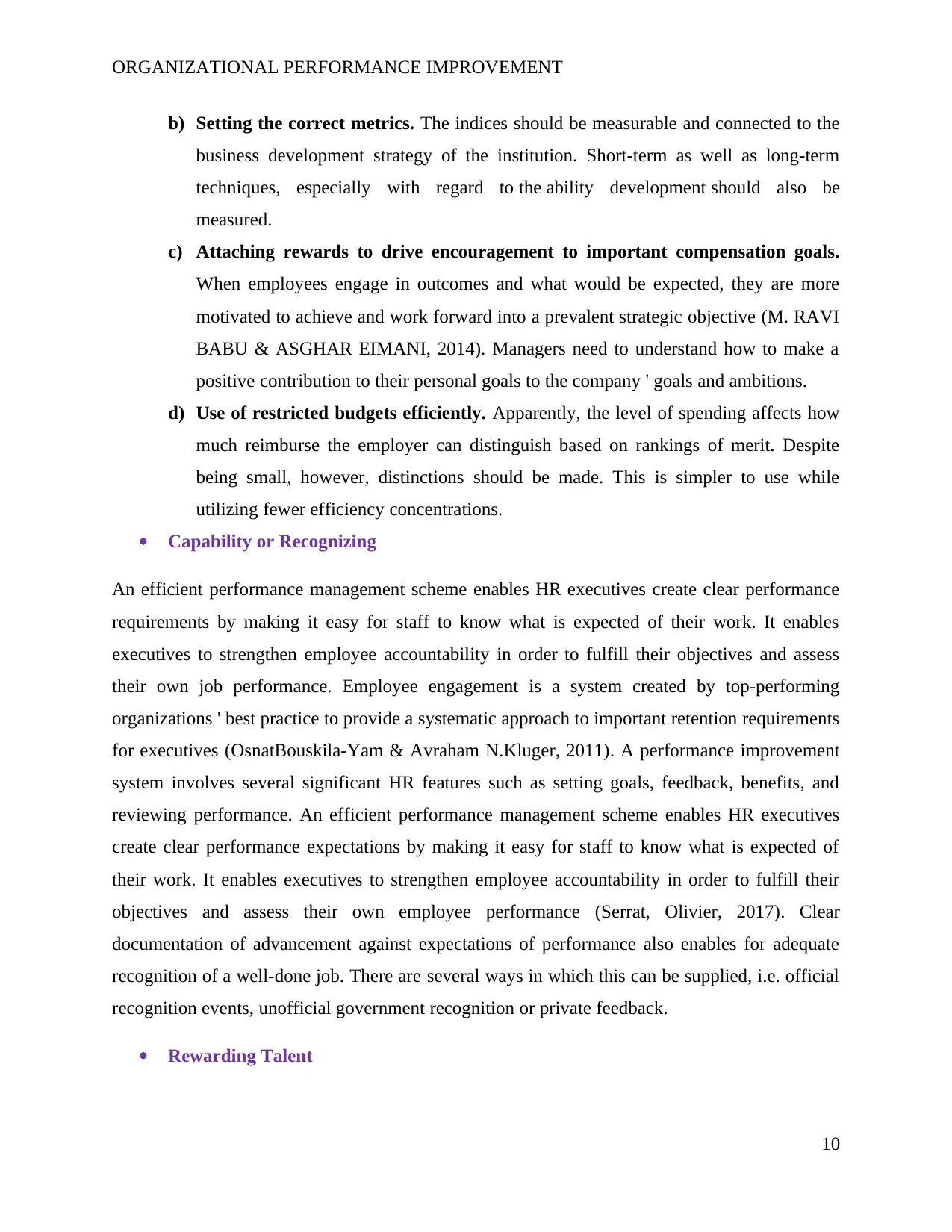
ORGANIZATIONAL PERFORMANCE IMPROVEMENT
b) Setting the correct metrics. The indices should be measurable and connected to the
business development strategy of the institution. Short-term as well as long-term
techniques, especially with regard to the ability development should also be
measured.
c) Attaching rewards to drive encouragement to important compensation goals.
When employees engage in outcomes and what would be expected, they are more
motivated to achieve and work forward into a prevalent strategic objective (M. RAVI
BABU & ASGHAR EIMANI, 2014). Managers need to understand how to make a
positive contribution to their personal goals to the company ' goals and ambitions.
d) Use of restricted budgets efficiently. Apparently, the level of spending affects how
much reimburse the employer can distinguish based on rankings of merit. Despite
being small, however, distinctions should be made. This is simpler to use while
utilizing fewer efficiency concentrations.
Capability or Recognizing
An efficient performance management scheme enables HR executives create clear performance
requirements by making it easy for staff to know what is expected of their work. It enables
executives to strengthen employee accountability in order to fulfill their objectives and assess
their own job performance. Employee engagement is a system created by top-performing
organizations ' best practice to provide a systematic approach to important retention requirements
for executives (OsnatBouskila-Yam & Avraham N.Kluger, 2011). A performance improvement
system involves several significant HR features such as setting goals, feedback, benefits, and
reviewing performance. An efficient performance management scheme enables HR executives
create clear performance expectations by making it easy for staff to know what is expected of
their work. It enables executives to strengthen employee accountability in order to fulfill their
objectives and assess their own employee performance (Serrat, Olivier, 2017). Clear
documentation of advancement against expectations of performance also enables for adequate
recognition of a well-done job. There are several ways in which this can be supplied, i.e. official
recognition events, unofficial government recognition or private feedback.
Rewarding Talent
10
b) Setting the correct metrics. The indices should be measurable and connected to the
business development strategy of the institution. Short-term as well as long-term
techniques, especially with regard to the ability development should also be
measured.
c) Attaching rewards to drive encouragement to important compensation goals.
When employees engage in outcomes and what would be expected, they are more
motivated to achieve and work forward into a prevalent strategic objective (M. RAVI
BABU & ASGHAR EIMANI, 2014). Managers need to understand how to make a
positive contribution to their personal goals to the company ' goals and ambitions.
d) Use of restricted budgets efficiently. Apparently, the level of spending affects how
much reimburse the employer can distinguish based on rankings of merit. Despite
being small, however, distinctions should be made. This is simpler to use while
utilizing fewer efficiency concentrations.
Capability or Recognizing
An efficient performance management scheme enables HR executives create clear performance
requirements by making it easy for staff to know what is expected of their work. It enables
executives to strengthen employee accountability in order to fulfill their objectives and assess
their own job performance. Employee engagement is a system created by top-performing
organizations ' best practice to provide a systematic approach to important retention requirements
for executives (OsnatBouskila-Yam & Avraham N.Kluger, 2011). A performance improvement
system involves several significant HR features such as setting goals, feedback, benefits, and
reviewing performance. An efficient performance management scheme enables HR executives
create clear performance expectations by making it easy for staff to know what is expected of
their work. It enables executives to strengthen employee accountability in order to fulfill their
objectives and assess their own employee performance (Serrat, Olivier, 2017). Clear
documentation of advancement against expectations of performance also enables for adequate
recognition of a well-done job. There are several ways in which this can be supplied, i.e. official
recognition events, unofficial government recognition or private feedback.
Rewarding Talent
10
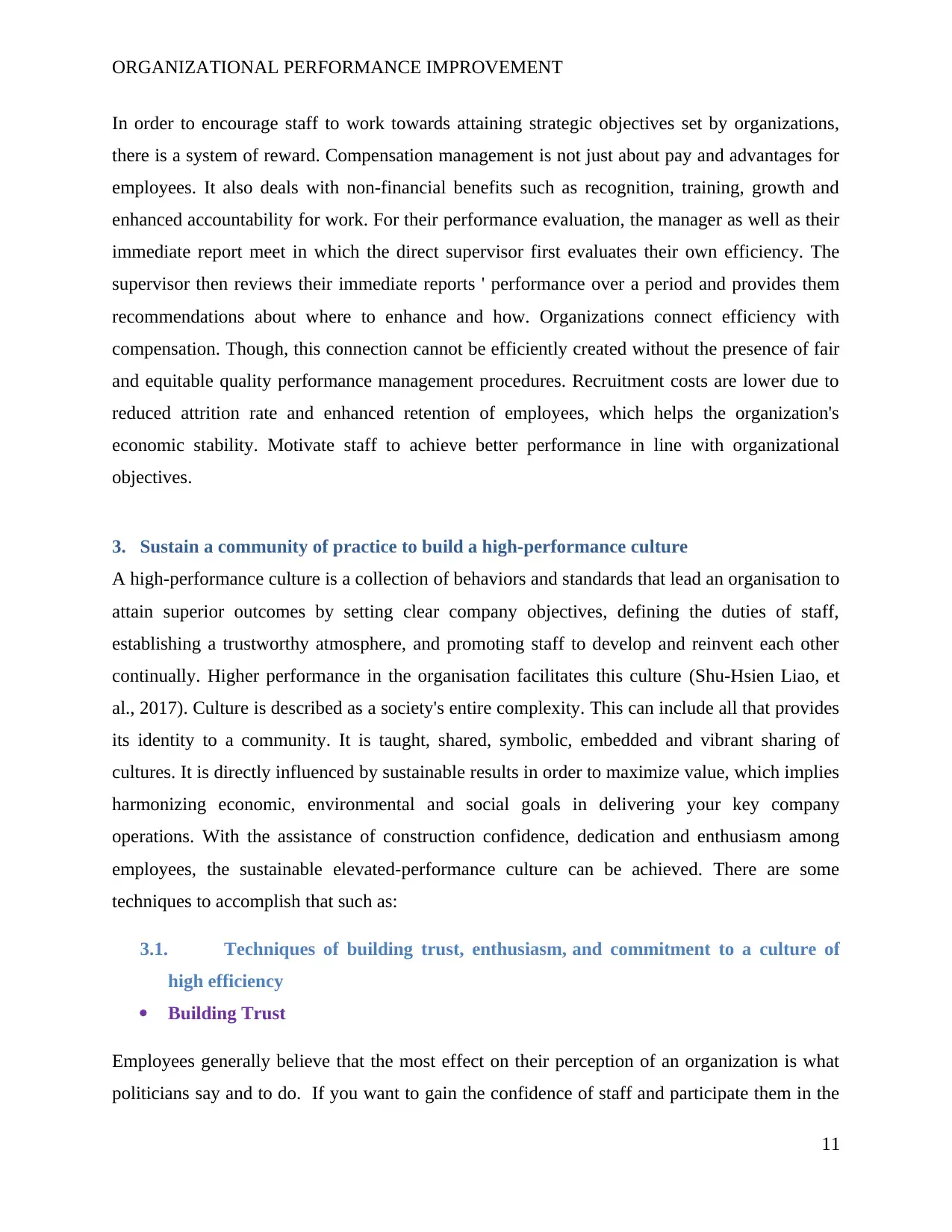
ORGANIZATIONAL PERFORMANCE IMPROVEMENT
In order to encourage staff to work towards attaining strategic objectives set by organizations,
there is a system of reward. Compensation management is not just about pay and advantages for
employees. It also deals with non-financial benefits such as recognition, training, growth and
enhanced accountability for work. For their performance evaluation, the manager as well as their
immediate report meet in which the direct supervisor first evaluates their own efficiency. The
supervisor then reviews their immediate reports ' performance over a period and provides them
recommendations about where to enhance and how. Organizations connect efficiency with
compensation. Though, this connection cannot be efficiently created without the presence of fair
and equitable quality performance management procedures. Recruitment costs are lower due to
reduced attrition rate and enhanced retention of employees, which helps the organization's
economic stability. Motivate staff to achieve better performance in line with organizational
objectives.
3. Sustain a community of practice to build a high-performance culture
A high-performance culture is a collection of behaviors and standards that lead an organisation to
attain superior outcomes by setting clear company objectives, defining the duties of staff,
establishing a trustworthy atmosphere, and promoting staff to develop and reinvent each other
continually. Higher performance in the organisation facilitates this culture (Shu-Hsien Liao, et
al., 2017). Culture is described as a society's entire complexity. This can include all that provides
its identity to a community. It is taught, shared, symbolic, embedded and vibrant sharing of
cultures. It is directly influenced by sustainable results in order to maximize value, which implies
harmonizing economic, environmental and social goals in delivering your key company
operations. With the assistance of construction confidence, dedication and enthusiasm among
employees, the sustainable elevated-performance culture can be achieved. There are some
techniques to accomplish that such as:
3.1. Techniques of building trust, enthusiasm, and commitment to a culture of
high efficiency
Building Trust
Employees generally believe that the most effect on their perception of an organization is what
politicians say and to do. If you want to gain the confidence of staff and participate them in the
11
In order to encourage staff to work towards attaining strategic objectives set by organizations,
there is a system of reward. Compensation management is not just about pay and advantages for
employees. It also deals with non-financial benefits such as recognition, training, growth and
enhanced accountability for work. For their performance evaluation, the manager as well as their
immediate report meet in which the direct supervisor first evaluates their own efficiency. The
supervisor then reviews their immediate reports ' performance over a period and provides them
recommendations about where to enhance and how. Organizations connect efficiency with
compensation. Though, this connection cannot be efficiently created without the presence of fair
and equitable quality performance management procedures. Recruitment costs are lower due to
reduced attrition rate and enhanced retention of employees, which helps the organization's
economic stability. Motivate staff to achieve better performance in line with organizational
objectives.
3. Sustain a community of practice to build a high-performance culture
A high-performance culture is a collection of behaviors and standards that lead an organisation to
attain superior outcomes by setting clear company objectives, defining the duties of staff,
establishing a trustworthy atmosphere, and promoting staff to develop and reinvent each other
continually. Higher performance in the organisation facilitates this culture (Shu-Hsien Liao, et
al., 2017). Culture is described as a society's entire complexity. This can include all that provides
its identity to a community. It is taught, shared, symbolic, embedded and vibrant sharing of
cultures. It is directly influenced by sustainable results in order to maximize value, which implies
harmonizing economic, environmental and social goals in delivering your key company
operations. With the assistance of construction confidence, dedication and enthusiasm among
employees, the sustainable elevated-performance culture can be achieved. There are some
techniques to accomplish that such as:
3.1. Techniques of building trust, enthusiasm, and commitment to a culture of
high efficiency
Building Trust
Employees generally believe that the most effect on their perception of an organization is what
politicians say and to do. If you want to gain the confidence of staff and participate them in the
11
⊘ This is a preview!⊘
Do you want full access?
Subscribe today to unlock all pages.

Trusted by 1+ million students worldwide
1 out of 18
Related Documents
Your All-in-One AI-Powered Toolkit for Academic Success.
+13062052269
info@desklib.com
Available 24*7 on WhatsApp / Email
![[object Object]](/_next/static/media/star-bottom.7253800d.svg)
Unlock your academic potential
Copyright © 2020–2025 A2Z Services. All Rights Reserved. Developed and managed by ZUCOL.




